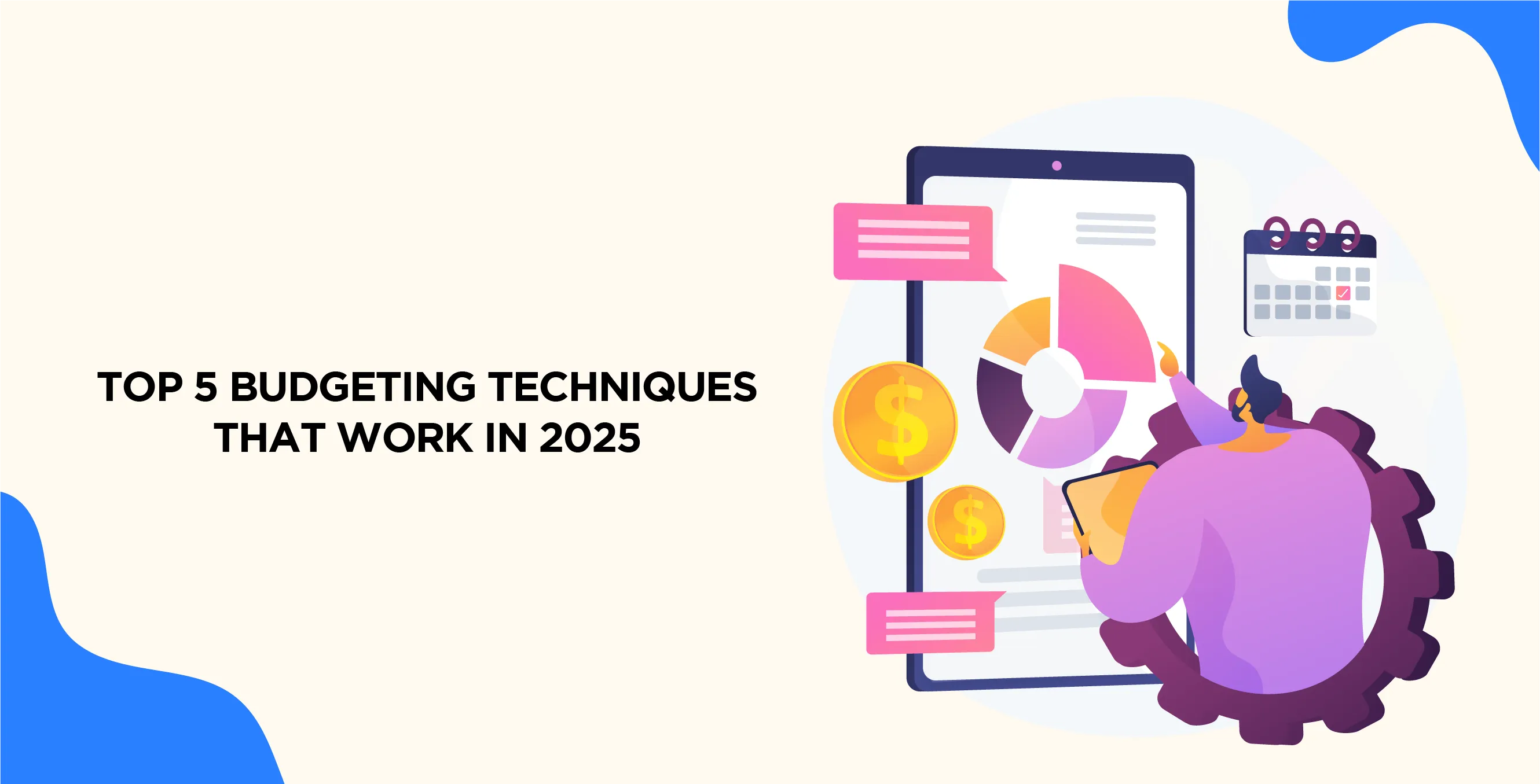
Author
LoansJagat Team
Read Time
12 Min
26 May 2025
Top 5 Budgeting Techniques That Work in 2025
In 2025, with rising inflation, digital payments, and increasing lifestyle expenses, smart budgeting is not just an option – it has become a necessity. Whether you are managing monthly expenses from a salary or earning income through freelancing, the right budgeting can help you achieve your financial goals faster and more easily.
In this blog, we will talk about 5 budgeting techniques that actually work in today’s time, without needing any complicated Excel sheets or heavy financial tools.
So, if you also want to grow your savings and keep your expenses under control, this guide is for you.
1. Track Finances
Tracking your finances is an important and effective budgeting technique in 2025. Until you know where your money is going, you can not control your expenses. The biggest benefit of this technique is that it gives you financial awareness, which helps you plan better for your goals.
Why is it important to track your finances?
- Understand your spending habits: When you record every expense, you start to see where your money is going — on needs or unnecessary luxuries.
- Avoid overspending: When you know how much you have spent in a month, you can avoid emotional or impulsive spending.
- Achieve financial goals: By tracking your income and expenses accurately, you can plan better for saving and investing.
Ashwini’s Example: A Real-Life Budget Tracker
Ashwini is a 24-year-old software engineer working in Bengaluru. He earns ₹50,000 per month. To track his expenses, he created a simple spreadsheet where he divided his fixed and variable expenses.
Ashwini’s Monthly Budget
Category | Type | Monthly Amount |
Salary | Income | ₹50,000 |
Rent | Fixed | ₹15,000 |
Utilities (Electricity, Water, Internet) | Fixed | ₹3,000 |
Groceries | Variable | ₹5,000 |
Transportation (Metro, Fuel) | Variable | ₹2,000 |
Dining Out | Variable | ₹2,500 |
Subscriptions (OTT, Gym) | Fixed | ₹1,500 |
Shopping (Clothes, Gadgets) | Variable | ₹3,000 |
Savings | Fixed | ₹10,000 |
Emergency Fund | Fixed | ₹5,000 |
Total Expenses | ₹47,000 | |
Balance | ₹3,000 |
did Ashwini learn?
- Identified overspending: When Ashwini tracked his expenses, he realised he was spending too much on dining out and shopping. So, he reduced spending in those areas.
- Increased savings: After tracking his expenses, he decided to save ₹10,000 monthly and put ₹5,000 into an emergency fund. This gave him a stronger financial cushion.
- Developed financial discipline: With regular tracking, Ashwini controlled his spending habits and avoided unnecessary expenses.
How can you start?
- Manual tracking: Start writing down your daily expenses in a notebook or spreadsheet.
Read More – How to Use the ‘Envelope System’ to Control Your Spending in 2025 - Use budgeting apps: Nowadays, many apps like Mint, YNAB (You Need A Budget), or PocketGuard link to your bank accounts and help track your expenses automatically.
- Weekly review: Review your expenses every week to make adjustments on time.
Tracking your finances is a basic but powerful budgeting habit. It helps you take control of your money. For young professionals like Ashwini, developing this habit can lead to long-term financial stability. When you track your income and expenses properly, you can make better financial decisions and reach your goals more effectively.
2. Avoid Debt
In today’s financial world, staying out of debt is not just a choice – it is a need.
In 2025, because of high credit card interest rates, Buy Now Pay Later (BNPL) schemes, and instant loan apps, people easily fall into debt traps. That’s why being debt-free needs conscious and disciplined effort.
Let’s understand this better with Gunjan’s story and how a simple and practical approach helped her stay away from debt.
Gunjan’s Story: A Real-Life Example
Gunjan is a 26-year-old software engineer in Bengaluru. Her monthly salary is ₹60,000. Earlier, she used to spend money without any planning, which led her to a credit card debt of ₹1,20,000.
But later, she changed her financial habits and followed a structured budgeting plan.
Here is a comparison table of her old and new budget:
Category | Before (₹) | Now (₹) | Change |
Rent | 15,000 | 15,000 | No Change |
Groceries | 8,000 | 6,000 | ₹2,000 saved |
Dining Out | 5,000 | 2,000 | ₹3,000 saved |
Subscriptions & OTT | 2,500 | 1,000 | ₹1,500 saved |
Shopping | 6,000 | 2,000 | ₹4,000 saved |
Travel & Entertainment | 4,000 | 1,000 | ₹3,000 saved |
Credit Card EMI | 10,000 | 5,000 | ₹5,000 saved |
Savings & Emergency Fund | 0 | 8,000 | ₹8,000 saved |
Total | 50,500 | 40,000 | ₹10,500 saved |
Gunjan reduced her extra spending (like dining out, shopping, and entertainment) and focused more on saving money and paying off her debt.
Practical Steps to Avoid Debt
- Use the 50/30/20 Rule: Divide your income — 50% for needs (like rent, groceries), 30% for wants (like shopping, fun), and 20% for savings and debt repayment.
- Clear high-interest debts first: Try to pay off credit cards and other loans with high interest as a priority.
- Avoid buying things without thinking: Follow the 24-hour rule — wait for 24 hours before buying anything and ask, “Do I really need this?”
- Create an emergency fund: Save money equal to 3–6 months of your expenses for emergencies.
- Use the Debt Snowball or Avalanche Method: Snowball Method: Pay off the smallest debts first to feel motivated.
- Avalanche Method: Pay off the highest interest debts first to save more money.
Gunjan’s Results
In just 6 months, Gunjan reduced her credit card debt from ₹1,20,000 to ₹45,000. She also saved ₹48,000 in her emergency fund. Now, she is free from financial stress and can focus on her goals.
Becoming debt-free does not happen in one day. But with proper budgeting and smart spending, it is possible.
Just like Gunjan, you can also change your money habits and avoid debt.
You can start small, but the result will be big.
3. Choose A Budgeting Method
To achieve your financial goals, choosing the right budgeting method is very important.
In 2025, there are many types of budgeting methods available that work according to your income and lifestyle.
1. Zero-Based Budgeting (ZBB)
In this method, you assign every single rupee to a category so that income minus expenses equals zero.
This approach makes you justify every expense, which helps reduce unnecessary spending.
Example:
Category | Amount (₹) |
Rent | 15,000 |
Groceries | 6,000 |
Utilities | 3,000 |
Transportation | 4,000 |
Savings | 10,000 |
Investments | 7,000 |
Entertainment | 3,000 |
Miscellaneous Expenses | 2,000 |
Total | 50,000 |
In this example, the total income is ₹50,000, and every rupee is assigned, so nothing is left unplanned.
2. 50/30/20 Rule
This is a simple and practical method where you divide your income into three parts:
- 50% for Needs (important expenses like rent, groceries)
- 30% for Wants (like shopping, dining, fun)
- 20% for Savings & Debt Repayment
Example:
Category | Amount (₹) |
Needs (50%) | 25,000 |
Wants (30%) | 15,000 |
Savings & Debt (20%) | 10,000 |
Total | 50,000 |
With this method, you can balance your essential needs, personal wants, and savings.
3. Envelope System
This traditional method involves dividing cash into separate envelopes for each expense category.
Once an envelope is empty, you stop spending in that category.
Example:
Envelope | Amount (₹) |
Rent | 15,000 |
Groceries | 6,000 |
Transportation | 4,000 |
Entertainment | 3,000 |
Miscellaneous | 2,000 |
Savings | 10,000 |
Total | 40,000 |
This method is great for people who prefer cash and want to avoid overspending.
4. Pay-Yourself-First Budgeting
In this method, you first set aside money for savings, then use the rest for your expenses.
It helps you reach long-term financial goals more easily.
Example:
Category | Amount (₹) |
Savings | 10,000 |
Rent | 15,000 |
Groceries | 6,000 |
Utilities | 3,000 |
Transportation | 4,000 |
Entertainment | 2,000 |
Miscellaneous Expenses | 2,000 |
Total | 42,000 |
This method helps you make savings a priority and increases financial security.
5. Value-Based Budgeting
In this method, you create your budget based on your values and priorities.
It allows you to spend more on things that matter most to you.
Example:
Category | Amount (₹) |
Travel (Priority) | 10,000 |
Rent | 15,000 |
Groceries | 6,000 |
Utilities | 3,000 |
Savings | 5,000 |
Enteratinment | 4,000 |
Miscellaneous Expenses | 2,000 |
Total | 45,000 |
If travel is important to you, you can spend more in that category while cutting back on others.
Each budgeting method has its unique style. You should choose one based on your income, expenses, and financial goals.
Whether you want the discipline of Zero-Based Budgeting or the simplicity of the 50/30/20 rule, the right method can help you move towards financial stability and growth.
4. Boost Your Pension
In today's world, with increasing life expectancy and rising inflation, creating a strong pension plan has become very important. In 2025, retirement planning is not just an option but a necessity for financial independence.
Practical Ways to Boost Your Pension
1. Start Early
The earlier you start investing for your pension, the more you can benefit from compounding.
For example, if you invest ₹5,000 per month at the age of 30 and get an average 10% annual return, by the time you turn 60, you could have a corpus of ₹1,14,00,000.
2. Diversify – Balance Safe and Growth Assets
Include both safe options like NPS (National Pension System) and PPF (Public Provident Fund), along with growth-oriented instruments like mutual funds and ULIPs in your portfolio.
This diversification protects you from market volatility and gives you a chance for better returns.
3. Take Full Advantage of Tax Benefits
You get a tax deduction of up to ₹1,50,000 under Section 80C for NPS and an additional ₹50,000 under Section 80CCD(1B).
PPF and EPF are also tax-saving instruments that can boost your pension corpus.
4. Regular Review and Rebalancing
Review your investment portfolio every year and rebalance the asset allocation if needed.
This ensures your portfolio remains aligned with your retirement goals.
A Pension Planning Example
Manoj, a 35-year-old IT professional, wants a monthly pension of ₹50,000 by the time he turns 60.
To boost his pension corpus, he adopted the following methods:
Investment Instrument | Monthly Contribution (₹) | Expected Annual Return (%) | Corpus at 60 (₹) |
National Pension System (NPS) | 5,000 | 10 | 1.14 crore |
Public Provident Fund (PPF) | 5,000 | 7 | 76 lakh |
Equity Mutual Funds (SIP) | 5,000 | 12 | 1.5 crore |
Total | 15,000 | — | 3.4 crore |
By investing ₹15,000 per month, Manoj built a ₹3,40,00,000 retirement corpus, which will help him generate a ₹50,000 monthly pension.
Boosting your pension requires a disciplined and planned approach. Starting early, choosing the right investment instruments, fully utilising tax benefits, and regularly reviewing your portfolio can make your retirement financially secure.
5. Don’t Forget About Savings
In today’s dynamic financial environment, saving money is not just an option – it has become a necessity. No matter what your income level is, regular savings protect you from financial emergencies and help you achieve your future goals.
Importance of Savings
- Emergency Fund: For unexpected situations like job loss, medical emergencies, or urgent repairs, having an emergency fund is important. Experts now recommend having an emergency fund equal to 12 months of essential expenses.
- Financial Freedom: With regular savings, you can achieve financial freedom for goals like buying a house, planning vacations, or retiring comfortably.
Also Read - The 50-30-20 Rule: Why It’s the Best Budgeting Strategy - The benefit of Compound Interest: The earlier you start saving, the more you can benefit from compound interest, which grows your money exponentially over time.
A Practical Example of Savings
Samarth, a 30-year-old software engineer from Bengaluru, earns ₹70,000 per month. He decided to allocate 20% of his monthly income towards savings.
Category | Monthly Allocation (₹) | Annual Allocation (₹) | Interest Rate (%) | Maturity Amount After 5 Years (₹) |
Public Provident Fund (PPF) | 5,000 | 60,000 | 7.1 | 3,60,000 |
Recurring Deposit (RD) | 3,000 | 36,000 | 6.5 | 2,16,000 |
Mutual Funds (SIP) | 6,000 | 72,000 | 12 | 4,32,000 |
Total Savings | 14,000 | 1,68,000 | — | 10,08,000 |
So, in 5 years, Samarth grew his savings to more than ₹10,00,000, which will help him with future goals like buying a house or retirement planning.
Tips to Boost Savings
- Automate Savings: Set a fixed amount to be automatically transferred to your savings account or investment schemes right after your salary is credited.
- Set Clear Goals: Define your short-term and long-term financial goals – like a vacation, education, or retirement – and create specific saving plans for each.
- Review Regularly: Review your savings plan every 6 months and make adjustments if needed.
- Avoid Unnecessary Expenses: Avoid impulse buying and track your expenses to save more.
Saving is a disciplined habit that leads you toward financial stability and independence. With regular savings, you can not only handle emergencies but also fulfil your dreams.
Start your savings journey today and secure your future.
Conclusion
The path to financial freedom starts with budgeting and disciplined saving. In 2025, when expenses are rising and financial challenges are becoming more complex, managing your money smartly has become very important.
Whether it’s tracking expenses like Ashwini, staying out of debt like Gunjan, or planning early for retirement like Manoj, everyone can improve their financial stability.
While choosing a budgeting method, understand your lifestyle and goals so you can stay in control of your money. Don’t ignore savings because an emergency fund and long-term investments help reduce financial stress in the future.
Even small steps matter – saving a little, investing a little, and avoiding unnecessary expenses – all these together make you financially secure. You just need discipline and consistency.
Start today so your tomorrow can be stress-free!
FAQs
1. Why is tracking expenses important for budgeting?
Tracking expenses helps you understand where your money goes so you can control unnecessary spending and save more effectively. It also makes it easier to plan for future financial goals.
2. How can I avoid falling into debt?
Avoid impulsive spending, prioritise paying off high-interest debt first, and follow a structured budget like the 50/30/20 rule to balance needs, wants, and savings.
3. What’s the best way to start saving for retirement early?
Start by investing a fixed amount monthly in schemes like NPS, PPF, or mutual funds to benefit from compounding. The sooner you begin, the more your money grows over time.
About the Author

LoansJagat Team
‘Simplify Finance for Everyone.’ This is the common goal of our team, as we try to explain any topic with relatable examples. From personal to business finance, managing EMIs to becoming debt-free, we do extensive research on each and every parameter, so you don’t have to. Scroll up and have a look at what 15+ years of experience in the BFSI sector looks like.

Quick Apply Loan
Subscribe Now
Related Blog Post


